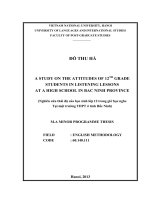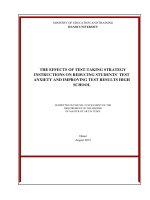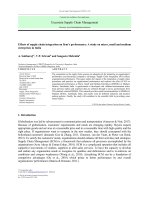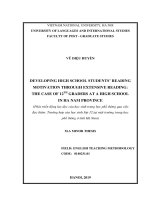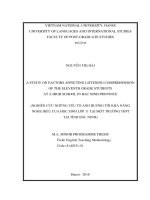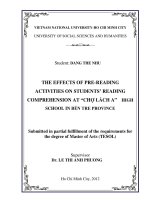Effects of reading strategy instructions on eleven graders performance a study at a high school in khanh hoa province
Bạn đang xem bản rút gọn của tài liệu. Xem và tải ngay bản đầy đủ của tài liệu tại đây (907.07 KB, 128 trang )
MINISTRY OF EDUCATION AND TRAINING
QUY NHON UNIVERSITY
PHAM THI HONG NGUYEN
EFFECTS OF READING STRATEGY INSTRUCTIONS
ON ELEVEN GRADERS’ PERFORMANCE:
A STUDY AT A HIGH SCHOOL
IN KHANH HOA PROVINCE
Field: Theory and Methodology of English Language Teaching
Code: 8040111
Supervisor: Assoc. Prof. Dr. Nguyen Quang Ngoan
BỘ GIÁO DỤC VÀ ĐÀO TẠO
TRƯỜNG ĐẠI HỌC QUY NHƠN
PHẠM THỊ HỒNG NGUYÊN
ẢNH HƯỞNG CỦA VIỆC HƯỚNG DẪN CHIẾN LƯỢC ĐỌC
VỚI KẾT QUẢ CỦA HỌC SINH LỚP 11: ĐIỂN CỨU TẠI
MỘT TRƯỜNG TRUNG HỌC PHỔ THÔNG
Ở TỈNH KHÁNH HÒA
Ngành: Lý luận và phương pháp dạy học bộ môn Tiếng Anh
Mã số: 8040111
Người hướng dẫn: PGS. TS. Nguyễn Quang Ngoạn
i
STATEMENT OF AUTHORSHIP
I confirm that the work presented in this research report has been
performed and interpreted solely by myself except where explicitly identified
to the contrary. I confirm that this work is submitted in partial fulfilment for
my M.A. degree in Theory and Methodology of English Language Teaching
and has not been submitted elsewhere in any other form for the fulfilment of
any other degree or qualification. This paper does not contain any material or
content previously published or written by another paper or anyone else.
Binh Dinh, November 2023
Pham Thi Hong Nguyen
ii
ACKNOWLEDGEMENTS
I would like to express my sincere gratitude to all those who have contributed
to the completion of this master's thesis.
First and foremost, I am deeply thankful to my esteemed supervisor, Assoc.
Prof. Dr. Nguyen Quang Ngoan, for his invaluable guidance, encouragement, and
unwavering support throughout this research journey. His expertise, insightful
feedback, and dedication have been instrumental in shaping the direction and quality
of this work.
I am also indebted to the lecturers of the Department of Foreign Languages for
their encouragement and valuable input during my study. Their lectures, seminars,
and academic discussions have broadened my knowledge and honed my research
skills.
I would like to offer my profound gratitude to all the participants who
generously shared their time and insights, without whom this research would not have
been possible.
Last but not least, special thanks are due to my family for their constant love,
encouragement, and belief in my abilities. Their unwavering support and
understanding during moments of stress have been a constant source of motivation.
In one word, the successful completion of this thesis would not have been
possible without the collective efforts and encouragement of all the individuals
mentioned above. Their contributions have left an indelible mark on my academic
and personal growth, for which I am sincerely grateful.
iii
ABSTRACT
This study investigates the impact of reading strategy instructions on the
academic performance of eleventh-grade students at a high school in Khanh Hoa
Province. The aim of this study is to explore whether explicit instructions on reading
strategies positively influence students' reading comprehension and overall academic
achievement. The research employs a mixed-methods approach, incorporating both
qualitative and quantitative data collection methods. A pre-test and post-test design
is utilized to assess the students' reading abilities before and after the implementation
of the reading strategy instructions. Additionally, focused group interviews are
conducted to gain insights into the students' perceptions and experiences regarding
the intervention. The findings reveal that the provision of explicit reading strategy
instructions significantly improves the students' reading comprehension and
academic performance. Students demonstrate a higher level of engagement with the
reading material and exhibit improved critical thinking skills, allowing them to better
process and analyze the content. The qualitative data further elucidates the students'
positive attitudes towards the reading strategy instructions, highlighting the perceived
benefits and challenges encountered during the intervention. The implications of this
research emphasize the importance of integrating explicit reading strategy
instructions into the curriculum to enhance students' reading abilities and overall
academic achievement. Educators and policymakers can use these insights to develop
effective teaching methodologies that promote a deeper understanding of texts and
foster a more positive learning environment. This study contributes to the existing
literature on reading instructions and provides valuable insights for educators seeking
to optimize reading comprehension skills among high school students.
Keywords: reading strategy instructions, reading comprehension skills,
performance, benefits, challenges, intervention, reading abilities
iv
TABLE OF CONTENTS
STATEMENT OF AUTHORSHIP .............................................................................i
ACKNOWLEDGEMENTS ........................................................................................ii
ABSTRACT .............................................................................................................. iii
TABLE OF CONTENTS...........................................................................................iv
LIST OF ABBREVIATIONS ...................................................................................vii
LIST OF TABLES .................................................................................................. viii
LIST OF FIGURES....................................................................................................ix
Chapter 1. Introduction............................................................................................1
1.1. Research Rationale ..........................................................................................1
1.1.1. Theoretical Reasons .............................................................................................. 1
1.1.2. Contextual Reasons............................................................................................... 2
1.2. Research Aim and Objectives..........................................................................3
1.2.1. Research Aim ........................................................................................................ 3
1.2.2. Research Objectives.............................................................................................. 3
1.3. Research Questions..........................................................................................4
1.4. Research Scope ................................................................................................4
1.5. Research Significance......................................................................................4
1.6. Structure of the Thesis .....................................................................................5
Chapter 2. Literature Review ..................................................................................7
2.1. Theoretical Background...................................................................................7
2.1.1. Definition of Reading ........................................................................................... 7
2.1.2. Teaching Reading ................................................................................................. 8
2.1.2.1. Pre-reading Activities .......................................................................8
2.1.2.2. While-reading Activities ...................................................................8
2.1.2.3. Post-reading Activities......................................................................9
2.1.3. Difficulties in Reading Comprehension ............................................................. 9
2.1.4. Reading Strategies............................................................................................... 10
2.1.4.1. Defining Strategies..........................................................................10
v
2.1.4.2. Metacognitive Strategies.................................................................11
2.1.4.3. Cognitive Strategies ........................................................................11
2.1.4.4. Social/ Affective Strategies.............................................................12
2.1.5. The Importance of Strategies in the Learning Process .................................... 13
2.1.6. Reading Strategy Instruction.............................................................................. 15
2.1.7. Types of Reading Tasks in the Textbook “TIẾNG ANH 11” and Strategies in
Reading Comprehension ........................................................................................................ 16
2.1.7.1. True/ False/ Not Given Statements .................................................16
2.1.7.2. Matching Headings .........................................................................17
2.1.7.3. Multiple Choice Questions .............................................................18
2.1.7.4. Finding Out the Main Idea ..............................................................18
2.1.7.5. Dealing With Vocabulary ...............................................................19
2.2. Previous Related Studies ...............................................................................19
Chapter 3. Methodology .........................................................................................26
3.1. Research Approach ........................................................................................26
3.2. Research Setting and Participants..................................................................27
3.3. Research Instruments.....................................................................................29
3.3.1. The Questionnaire ............................................................................................... 29
3.3.2. The Pre-Test and Post-Test ................................................................................ 30
3.3.3. The Interview....................................................................................................... 32
3.4. Research Procedure........................................................................................32
3.4.1. Pilot Study............................................................................................................ 32
3.4.2. Data Collection.................................................................................................... 33
3.4.3. Data Analysis....................................................................................................... 33
Chapter 4. Findings and Discussion ......................................................................38
4.1. Findings from the Pre-Test ............................................................................38
4.1.1. Summary of Pre-Test Administered to Participants ........................................ 38
4.1.2. Presentation of Pre-Test Scores and Performance ........................................... 38
4.2. Findings from the Post-Test...........................................................................41
4.2.1. Summary of Post-Test Administered to Participants ...................................... 41
4.2.2. Presentation of Post-Test Scores and Performance ......................................... 42
vi
4.2.3. Comparison between Pre-Test and Post-Test Results ..................................... 44
4.3. Findings from the Questionnaire ...................................................................47
4.3.1. Participants' Perceptions of Difficulties in Learning the Reading Skill......... 47
4.3.1.1. Summary of the Questionnaire Administered to Participants ........47
4.3.1.2. Results of Participants' Perceptions of Difficulties in Learning the
Reading Skill................................................................................................47
4.3.2. Participants' Perceptions Toward Effects of Reading Strategy Instructions
.................................................................................................................................... 54
4.3.2.1. Summary of the Questionnaire Administered to Participants ........54
4.3.2.2. Results of Participants' Perceptions of Difficulties in Learning the
Reading Skill................................................................................................54
4.4. Findings from the Interview ..........................................................................62
4.4.1. Students' Perceptions of Difficulties in Learning the Reading Skill .............. 63
4.4.2. Participants' Perceptions Toward Effects of Reading Strategy Instructions
................................................................................................................................................... 66
Chapter 5. Conclusion ............................................................................................73
5.1. Summary of Key Findings of the Study ........................................................73
5.2. Pedagogical Implications...............................................................................75
5.3. Limitations and Suggestions for Further Research........................................76
References ................................................................................................................78
Appendices ...........................................................................................................PL.1
Appendix 1. Questionnaire ............................................................................... PL.1
Appendix 2. Interview questions ...................................................................... PL.9
Appendix 3. Interview transcription ............................................................... PL.10
Appendix 4. Pre-test (T1) ............................................................................... PL.20
Appendix 5. Post-test (T2).............................................................................. PL.27
vii
LIST OF ABBREVIATIONS
EFL: English as a Foreign Language
ESL: English as a Second Language
EL: English Language
SPSS: Statistical Package for the Social Sciences Software
MSI: Metacognitive Strategy Index
L1: First Language
L2: Second Language
T1: Pre-test
T2: Post-test
viii
LIST OF TABLES
Table 1. Participants’ Specifications.........................................................................28
Table 2. Mean Pre-Test Scores of the Experimental Group and Control Group......39
Table 3. T-test Result ................................................................................................39
Table 4. Distribution of Pre-Test Scores by Question Type .....................................40
Table 5. Mean Post-Test Scores of the Experimental Group and Control Group ....42
Table 6. Distribution of Post-Test Scores by Question Type ...................................43
Table 7. Comparison of Pre-Test and Post-Test Results ..........................................44
Table 8. Participants' Perceptions of Difficulties in Learning the Reading Skill .....48
Table 9. Participants' Perceptions toward Effects of Reading Strategy Instructions 54
Table 10. Results from Interview Question 1 ...........................................................63
Table 11. Results from Interview Question 2 ...........................................................67
Table 12. Results from Interview Question 3 ...........................................................70
ix
LIST OF FIGURES
Figure 1. Conceptual Framework of the Study .........................................................13
Figure 2. Comparison of Post-Test & Pre-Test Average Scores between Experimental
group and Control group ...........................................................................................46
Figure 3. Participants' Perceptions of Difficulties in Learning the Reading Skill ....51
Figure 4. Participants' Perceptions toward Effects of Reading Strategy Instructions
................................................................................................................................... 57
1
Chapter 1. Introduction
This chapter presents the rationale of the study, which includes theoretical and
contextual background for the study that discusses why the researcher decided to
undertake this research. Also, details about the aim and objectives, research
questions, scope, significance, and organization of the thesis are introduced.
1.1. Research Rationale
1.1.1. Theoretical Reasons
English is widely utilized in a variety of fields, including politics, economy,
tourism, telecommunication, culture, science, and technology. Since Vietnam
implemented its open-door policy toward regional and international integration,
English has gained increasing importance. As a result, to meet the expanding
demands in a rising nation like Vietnam, Vietnamese students must have a strong
command of English.
Along with speaking, listening, and writing, reading is one of the four language
skills taught in the English language learning process. Reading is regarded as the most
crucial skill among all others. Snow (1998) stated that “reading is essential to success
in our society. The ability to read is highly valued and important for social and
educational advancement.” In addition, according to Komiyama (2009), “reading
supports the development of overall proficiency and provides access to crucial
information at work and in school.” Reading in a second or foreign language has been
a significant component of language learning over the past forty years (Zoghi et al.,
2010). This significance has made reading education an important issue in
educational policy and practice for English language learners (Cheung & Slavin,
2005)
However, reading is a complex, interactive cognitive process of extracting
meaning from text. There are a lot of difficulties for the learners to achieve the goal
of mastering the content of the text and completing the enclosed task in the reading
2
requirement. In 1998, Vogel indicated that about 52% of adults with reading problems
had difficulties in learning a foreign language (Vogel & Reder, 1998). Schiff and
Calif (2004) further explained that EFL students had reading problems due to a lack
of understanding and awareness of how to use reading strategies. The researcher
needs to determine the causes of the learners' problems with English reading
comprehension. On the other hand, the main objective of all reading is about the
competence to understand a reading text. It implies that reading can be effective if
readers can fully understand the reading text. The process of comprehending the
reading text is not an easy task for the students. In this case, the teacher should employ
various techniques to enhance the learners' reading comprehension. It aims to aid
students in remembering new lexical items from the reading text in addition to
helping them quickly absorb general information in the reading text. Olviyanti et al.
(Olviyanti et al., 2011) claimed, “Reading comprehension strategies are tools that
proficient readers use to solve the comprehension problem they encounter in texts.”
As a result, EFL students must acquire sufficient reading strategies to construct the
text's meaning.
1.1.2. Contextual Reasons
Many high school students find reading comprehension to be one of the most
difficult aspects of the graduation examination. The difficulties encountered by these
language learners may be explained by a lack of reading strategies and a lack of
background knowledge of the given topics or the world in general. It is easy to see
that reading is an everyday ordinary task to which little thought is given, yet it is one
of the most important skills that learners acquire at school because it serves as the
foundation for all further learning. When reading in a foreign language is a laborious,
unpleasant, and unsuccessful experience, readers are often unwilling to read in the
target language. This explains why most EFL students dislike reading in English.
In addition, the parents’ unstable income which still depends much on the farm
work influences partly the quality of education because most of the family cannot
afford to invest in their children’s studies. Another reason is that a few parents whose
3
thought is not progressive are unaware of the importance of English and let their
children focus on Maths, Physics, and Chemistry. Moreover, the student’s
background of knowledge is rather lower than other schools in the region. Besides,
English is a foreign language in Vietnam, and English language students may have
difficulties in comprehending reading text. Many high school students find reading
comprehension the most difficult when taking their graduation exams. These
language learners' difficulties may be explained due to a lack of reading strategies
and background knowledge of the topics. Locally, the issue is frequently raised in
group meetings.
As an English teacher, the researcher has always understood the significance of
developing students' reading skills. Teachers must discover what motivates students
to read. Teachers must reawaken adolescent students' passion for reading. Therefore,
teachers must investigate the difficulties that individual students face. By examining
the issue, teachers can not only assist their students in overcoming reading challenges
but also foster and develop the motivation that already exists in engaged readers. In
addition, practicing reading skills regularly is always an interest of the researcher.
After reviewing related studies in terms of content and subject, the researcher found
some literature gaps that could be addressed in this study such as the research
participants, sample size, local student population, and research tool. This inspired
the researcher to carry out this study “Effects of reading strategy instructions on
eleven graders’ performance at a high school in Khanh Hoa Province”
1.2. Research Aim and Objectives
1.2.1. Research Aim
The general aim of this study is to investigate the effects of reading strategy
instructions on eleven graders’ performance at the investigated highschool.
1.2.2. Research Objectives
The specific objectives are set as follows:
- To investigate the difficulties in learning the reading skill perceived by EFL
4
eleven graders.
- To examine the effects of reading strategy instructions on EFL eleven
graders’ reading performance.
1.3. Research Questions
With the objectives stated above, the study focuses on answering two research
questions:
1. What are EFL eleven graders’ difficulties perceived in learning the reading
skill?
2. What are the effects of reading strategy instructions on EFL eleven graders’
reading performance?
1.4. Research Scope
The study aims to find out the difficulties in learning the reading skills perceived
by students in grade 11 and the effects of reading strategy instructions on their
performance., The research scope was narrowed down to 80 students from two classes
in grade 11 at Nguyen Chi Thanh High School, in Khanh Hoa Province. Students
study all four English skills in the official textbook; however, the study is limited
only to students’ English reading skills. The study was conducted in the second
semester of the academic year 2022 - 2023.
1.5. Research Significance
Practically, this research is likely to contribute to the following implications for
many people. Firstly, this research assists English teachers in selecting effective
methods for boosting students' reading comprehension. Secondly, students can
understand the types of learning strategies to accelerate and improve their reading
skills. In addition, learners can practice the concept of a good learning strategy for
reading on an academic and daily basis. Today’s students must be standardized in
English to “actively participate in the global community” (Vietnamese Ministry of
Education, The Decision No 1400/QĐ-TTg, 2008). The Project of Teaching and
5
Learning Foreign Languages in the National Education System from 2008 to 2020
was formed in 2008 specifically to increase student achievement in these areas.
Improving students’ English standards has become the mandate across all schools in
Vietnam (Vietnamese Ministry of Education, Decision No 1400/QĐ-TTg, 2008). The
researcher believes that all teachers in schools can positively influence students’
achievement and can play a significant role in students’ reading development. This
paper is beneficial to both teachers and students in upper secondary school. Thirdly,
this research is considered a useful reference or source of future data and also helps
future researchers move forward with a deeper insight for improving reading
comprehension. The role of reading skills in getting better other linguistic skills, as
well as the role of reading skills in our educational systems, is considered.
Theoretically, conducting reading strategy research in the context of
multilingual developing countries likely helps curriculum developers to make
constructive decisions about the improvement of programs. This study contributes to
studies on reading ability in Vietnam. Collecting different sets of data is to depict a
clearer picture of the use of strategies. It is hoped that the findings of this study can
contribute to basic reading knowledge and serve to stimulate curiosity and interest to
know more about strategy instruction approaches to teaching reading comprehension.
1.6. Structure of the Thesis
Thesis is presented in five chapters: Introduction, Literature Review,
Methodology, Findings and Discussion, Conclusions and Implications.
Chapter 1, Introduction, presents the rationale, which introduces the reasons
why the researcher chose to conduct the study, the aim, the research questions, the
scope, the significance and the structure of thesis.
Chapter 2, Literature Review, examines several underlying theoretical
constructs that framed this study. It also examines the relevant literature regarding 1)
Definition of reading, 2) Teaching reading, 3) Difficulties in reading comprehension,
4) Reading Strategies, 5) The importance of strategies in the learning process, 6)
6
Reading strategy instruction, 7) Types of reading tasks in the textbook “TIẾNG ANH
11” and strategies in reading comprehension, and 8) Previous related studies on the
implementation of EFL students’ learning reading skills.
Chapter 3, Methodology, explains the research methods. Firstly, it presents the
research approach. Secondly, it describes the research setting and participants.
Thirdly, it introduces the research instruments used to collect data. Lastly, this chapter
comes to an end with the procedure to conduct the study.
Chapter 4, Findings and Discussion, reports the results of the study. First of all,
the pre-test result is introduced. Second, the post-test result is presented. Then, the
information collected from the questionnaire is analyzed to give an in-depth
explanation of the findings. Last, the interview transcription analysis is the final
finding of this chapter.
Chapter 5, Conclusions and Implications, concludes the report of the study.
First, it summarizes the main findings of the study. Then, it suggests the research
implications. Finally, the limitations of the study and the suggestions for future
research make the last part of this chapter.
7
Chapter 2. Literature Review
This chapter presents the main concepts and terms building a theoretical
foundation for the study. In this chapter, the definition of reading, teaching reading,
difficulties in reading comprehension, reading strategy instruction, types of reading
tasks in the textbook “TIẾNG ANH 11” and strategies in reading comprehension are
written and explained in detail. Finally, previous related works conducted by other
researchers are reviewed in terms of their focuses and findings.
2.1. Theoretical Background
2.1.1. Definition of Reading
Reading is defined differently by each individual. According to Antar Abdellah
(2010), “Reading is an interactive skill. In this respect, the mental processes involved
are similar to those employed while listening. In both, the students are engaged in
decoding a message rather than encoding. Both require more than just a passive
knowledge of the vocabulary and structure of the language”. It is iin accordance with
Harris’s claim, “Reading is the meaningful interpretation of printed or written verbal
symbols which also involves sensing, perceiving, achieving meaning, learning,
reacting in a variety of ways” (Albert Josiah Harris, 1962). Additionally, Patel and
Jain (2008) contend that reading is a skill that requires the capacity for recognition
and comprehension and that it is an essential activity that keeps people up to date.
Nuttal (1982) defines reading as a meaningful interpretation of printed or written
verbal symbols. It means that reading is a result of the interaction between the
students; perception of graphic symbols that represent a language and their
knowledge of the world. In this process, the reader tries to recreate the meaning
intended by the writer.
Also, Grabe et al. (2011) assert that vocabulary and syntax are automatically
recognized when someone is reading. From these definitions, reading is an effort on the
part of the learners to assimilate or convey the information and meaning from the text by
8
comprehending, absorbing, interpreting, and giving the written form meaning.
Therefore, it can be concluded that reading involves more than just looking at
words represented by symbols on a page; it also involves understanding the meaning
of individual words in order to comprehend a text's content and to extract information
from it.
2.1.2. Teaching Reading
Teaching reading is the act of instructing individuals or groups on how to derive
meaning from text. When learning to read, learners are instructed to "guess" the word
they don't understand by using context clues and critical thinking techniques. To put
it another way, teaching reading is a multi-stage process that includes pre-, during,
and post-reading to drive a book's content and build students' reading skills so that
they can read an English text efficiently. Furthermore, Alysousef 2006) asserts that
modern reading tasks have three procedural stages pre-, during-, and post-reading -
in contrast to conventional reading materials. Pre-reading can help students engage
the relevant schema. While-reading is intended to improve students' ability to deal
with literature by broadening their linguistic and technical knowledge, the post-
reading stages include exercises, cut-up sentences, and comprehension questions to
help students improve their comprehension abilities. Alyousef also asserts that
reading class activities are divided into three stages: pre-, while- and post-reading.
2.1.2.1. Pre-reading Activities. Pre-reading stages occur before students begin to
read. This stage aims to acquaint students with the material they will be reading in order
for them to gain a basic understanding of the content and purpose of reading. At this point,
teachers attempt to engage students' schema related to the topic or quickly explain the text's
contents. Giving children fundamental text-related questions and guessing the content of a
reading text based on the title or image in a text are two activities that can be done at this
level.
2.1.2.2. While-reading Activities. A reading activity is something the reader does
while reading. This activity’s goal is to help the reader understand the content of a text. At
9
this point, the teacher may assign students tasks such as highlighting key points,
determining the purpose of the text, and determining its structure.
2.1.2.3. Post-reading Activities. A post-reading activity is something that readers
do after they finish reading. This stage is intended to assess students'/readers'
comprehension of the materials they have read. In this section, the instructor can engage
in a variety of activities, such as asking understanding questions and leading small group
discussions. Furthermore, Duffy (Gerald G. Duffy, 2009) states that when teaching reading
comprehension, teachers should consider two factors. First, reading comprehension is a
knowledge-based skill. It implies that in order to explain the reading text to students,
teachers ought to be familiar with it. Second, teachers must use effective strategies because
reading is a complex cognitive and linguistic activity that requires deciphering alphabetic
symbols.
2.1.3. Difficulties in Reading Comprehension
The process by which students recognize and interpret their reading
comprehension problems is referred to as students' perception. Gunning (Gunning,
2002) separates the reading issues into three categories: (1) Problems of language
knowledge, (2) Problems of background knowledge, (3) Problems of motivation, (4)
Problems of reading strategies, and (5) Problems of reading knowledge. It means that
the students' reading comprehension problems are caused by more than one factor.
First, phonological knowledge, semantic knowledge, syntactic knowledge,
morphemic knowledge, and pragmatic knowledge are all problems of language
knowledge. Second, background knowledge issues, or the condition in which readers
discover discrepancies between their prior knowledge and what the author intended
in the text (Yi, 2006). Another issue with background knowledge is the difficulty in
understanding some cultures' loaded words and phrases, even if the reader knows
every word in the text (Gunning, 2002, p.8). Third, there are motivational issues, or
students are less motivated to read. Less motivation to read is also one of the reasons
students struggle to meet their reading comprehension goals (Alderson, 2000). If
students are not interested in the topic they are reading about, they may struggle with
